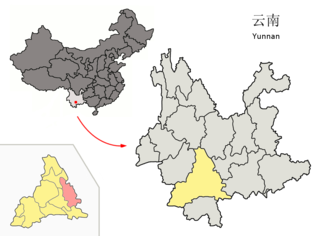
The Bulangpeople are an ethnic group. They form one of the 56 ethnic groups officially recognized by the People's Republic of China.
Bit is an Austroasiatic language spoken by around 2,000 people in Phongsaly Province, northern Laos and in Mengla County, Yunnan, China.

Mojiang Hani Autonomous County is an autonomous county under the jurisdiction of Pu'er City, in the south of Yunnan Province, China.

The Lolo-Burmese languages of Burma and Southern China form a coherent branch of the Sino-Tibetan family.
The U language or P'uman, is spoken by 40,000 people in the Yunnan Province of China and possibly Myanmar. It is classified as an Austroasiatic language in the Palaungic branch. In China, U speakers are classified as ethnic Bulang.
Lolopo is a Loloish language spoken by half a million Yi people of China. Chinese speakers call it Central Yi, as the name Lolopo do not exist in Chinese, and is one of the six Yi languages recognized by the government of China.
Lalo is a Loloish language cluster spoken in western Yunnan, China by 300,000 speakers. Speakers are officially part of the Yi nationality, and Chinese linguists refer to it as "Western Yi" due to its distribution in western Yunnan. Lalo speakers are mostly located in southern Dali Prefecture, especially Weishan County, considered the traditional homeland of the Lalo. Historically, this area is the home of the Meng clan, who ruled the Nanzhao Kingdom (737–902 CE). Many speakers of Core Lalo dialects claim to be descendants of the Meng clan.
Micha, or Miqie, is a Loloish language of Yunnan. Its usage is declining.
Awu, also known as Lope, is a Loloish language of China. Awu is spoken in Luxi, Mile, Luoping, and Shizong counties (Ethnologue). It is closely related to Nisu.
The Hani languages are a group of closely related but distinct languages of the Loloish (Yi) branch of the Tibeto-Burman linguistic group. They are also referred to as the Hanoid languages by Lama (2012) and as the Akoid languages by Bradley (2007).
Nuobi is a Loloish language of south-central Yunnan, China.
Nuomei is a Southern Loloish language of Yunnan, China. Nuomei is spoken in Yuanjiang Hani, Yi and Dai Autonomous County, and Jinping Miao, Yao, and Dai Autonomous County.
Duota is a Southern Loloish language of Yunnan, China. Duota is spoken in Jiangcheng Hani and Yi Autonomous County, Xinping Yi and Dai Autonomous County, and Yuanjiang Hani, Yi and Dai Autonomous County.
Duoni is a Southern Loloish language of Yunnan, China. Duoni is spoken in Jinping Miao, Yao, and Dai Autonomous County and Yuanyang County, Yunnan.
Baihong is a Southern Loloish language of Yunnan, China. It is spoken in Jiangcheng Hani and Yi Autonomous County, Mojiang Hani Autonomous County, Yuanjiang Hani, Yi and Dai Autonomous County, Lüchun County, and Yuanyang County, Yunnan.
Angluo is a Southern Loloish language of Yunnan, China. Angluo is spoken in Jinping Miao, Yao, and Dai Autonomous County and Yuanyang County, Yunnan.
Xiqi is an unclassified Loloish language of Huaning County, Yunnan, China. It is also called Siqipo 斯期颇 in Mile County.
Adu is an unclassified Loloish language of Huaning County, Yunnan, China.
Shehua is an unclassified Sinitic language spoken by the She people of Southeastern China. It is also called Shanha, San-hak (山哈) or Shanhahua (山哈话). Shehua speakers are located mainly in Fujian and Zhejiang provinces of Southeastern China, with smaller numbers of speakers in a few locations of Jiangxi, Guangdong and Anhui provinces.